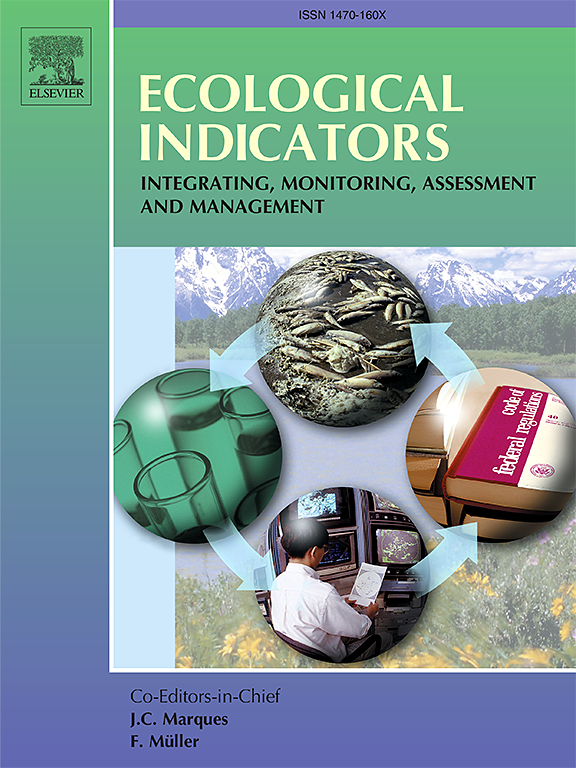Spatiotemporal patterns of abrupt vegetation changes and reversal trends in the Yellow River Basin: Climate and human drivers
IF 7
2区 环境科学与生态学
Q1 ENVIRONMENTAL SCIENCES
引用次数: 0
Abstract
Vegetation changes involve both gradual trends and abrupt changes, with the latter serving as critical indicators for detecting vegetation state transitions and identifying potential environmental stresses. In recent decades, the structure and function of vegetation ecosystems in the Yellow River Basin have undergone significant alterations. However, there remains limited understanding of whether abrupt changes occurred during these alterations and their driving mechanisms. So here, this study utilized the Normalized Difference Vegetation Index (NDVI) as a proxy for vegetation changes, characterized the spatiotemporal distribution of abrupt vegetation changes characteristics based on the Breaks for Additive Seasonal and Trend (BFAST) algorithm, and employed a Random Forest model to elucidate the driving factors behind these changes. The results showed that 73.1% of the vegetation in the basin experienced at least one abrupt change, with 2011 marking the peak year (9.8% affected area). Notably, 21.35% of pixels exhibited trend reversals, a phenomenon masked in previous linear trend studies. Regarding driving factors, positive abrupt changes were primarily driven by moderate warming and extreme precipitation anomalies, while the concentrated positive abrupt changes in 2011 were significantly influenced by the transition between dry and wet years and ecological restoration projects. In contrast, negative abrupt changes predominantly resulted from extreme temperatures and intensified human activities. These findings reveal the causes and response mechanisms of abrupt vegetation changes in the Yellow River Basin, providing new insights and perspectives for exploring the patterns of vegetation changes in this region.

黄河流域植被突变的时空格局及逆转趋势:气候和人类驱动因素
植被变化既有渐变趋势,也有突变趋势,突变趋势是检测植被状态转变和识别潜在环境胁迫的重要指标。近几十年来,黄河流域植被生态系统的结构和功能发生了重大变化。然而,对于在这些变化过程中是否发生突变及其驱动机制的了解仍然有限。因此,本研究利用归一化植被指数(NDVI)作为植被变化的代表,基于break for Additive Seasonal and Trend (BFAST)算法对植被突变特征的时空分布特征进行表征,并采用Random Forest模型对这些变化背后的驱动因素进行分析。结果表明:73.1%的流域植被发生过至少一次突变,2011年为突变高峰年(受影响面积为9.8%);值得注意的是,21.35%的像素表现出趋势逆转,这一现象在以前的线性趋势研究中被掩盖了。在驱动因子上,正突变主要受中度增温和极端降水异常驱动,而2011年的正突变集中受干湿年交替和生态恢复工程的显著影响。相反,负突变主要是由极端温度和人类活动加剧引起的。这些发现揭示了黄河流域植被突变的原因和响应机制,为探索该地区植被变化规律提供了新的见解和视角。
本文章由计算机程序翻译,如有差异,请以英文原文为准。
求助全文
约1分钟内获得全文
求助全文
来源期刊

Ecological Indicators
环境科学-环境科学
CiteScore
11.80
自引率
8.70%
发文量
1163
审稿时长
78 days
期刊介绍:
The ultimate aim of Ecological Indicators is to integrate the monitoring and assessment of ecological and environmental indicators with management practices. The journal provides a forum for the discussion of the applied scientific development and review of traditional indicator approaches as well as for theoretical, modelling and quantitative applications such as index development. Research into the following areas will be published.
• All aspects of ecological and environmental indicators and indices.
• New indicators, and new approaches and methods for indicator development, testing and use.
• Development and modelling of indices, e.g. application of indicator suites across multiple scales and resources.
• Analysis and research of resource, system- and scale-specific indicators.
• Methods for integration of social and other valuation metrics for the production of scientifically rigorous and politically-relevant assessments using indicator-based monitoring and assessment programs.
• How research indicators can be transformed into direct application for management purposes.
• Broader assessment objectives and methods, e.g. biodiversity, biological integrity, and sustainability, through the use of indicators.
• Resource-specific indicators such as landscape, agroecosystems, forests, wetlands, etc.
 求助内容:
求助内容: 应助结果提醒方式:
应助结果提醒方式:


